Business Communication Report: Austin Fraser Case Study Analysis
VerifiedAdded on 2020/07/22
|10
|2873
|65
Report
AI Summary
This report provides a comprehensive analysis of business communication within the Austin Fraser organization. It begins with an introduction to business communication, emphasizing its role in information sharing both internally and externally. The report then delves into various types of business information, including verbal, written, on-screen, multimedia, and web-based formats, along with their respective sources. It examines the appropriateness of different information types for strategic decision-making. The report further explores ethical and legal issues, such as data protection and ethical codes of practice, and operational issues like data security, backups, and business continuity. Finally, it discusses both electronic and non-electronic methods of communication, such as mobile phones, the internet, email, video conferencing, face-to-face interactions, and memoranda. The conclusion summarizes the key findings, highlighting the importance of effective business communication for organizational success.
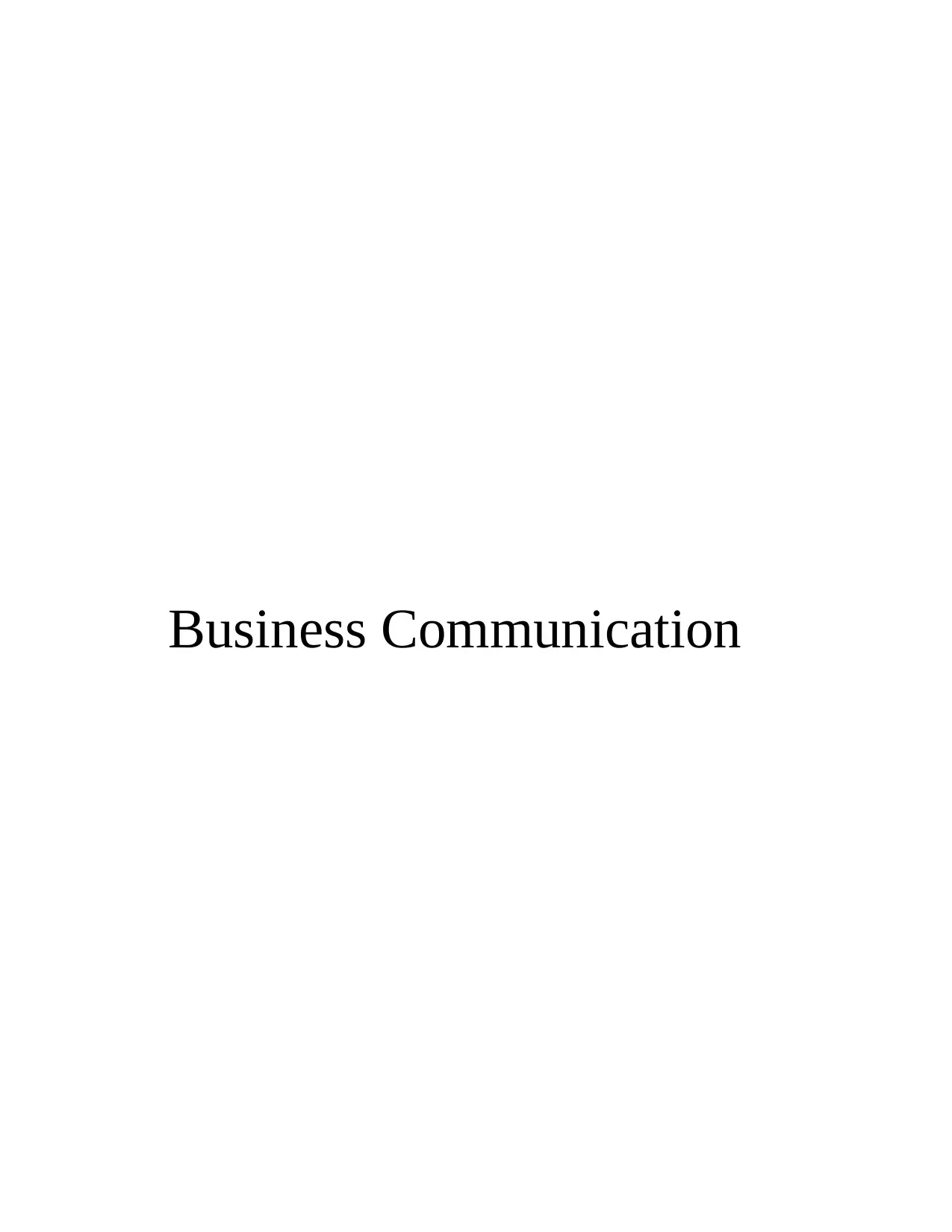
Business Communication
Paraphrase This Document
Need a fresh take? Get an instant paraphrase of this document with our AI Paraphraser
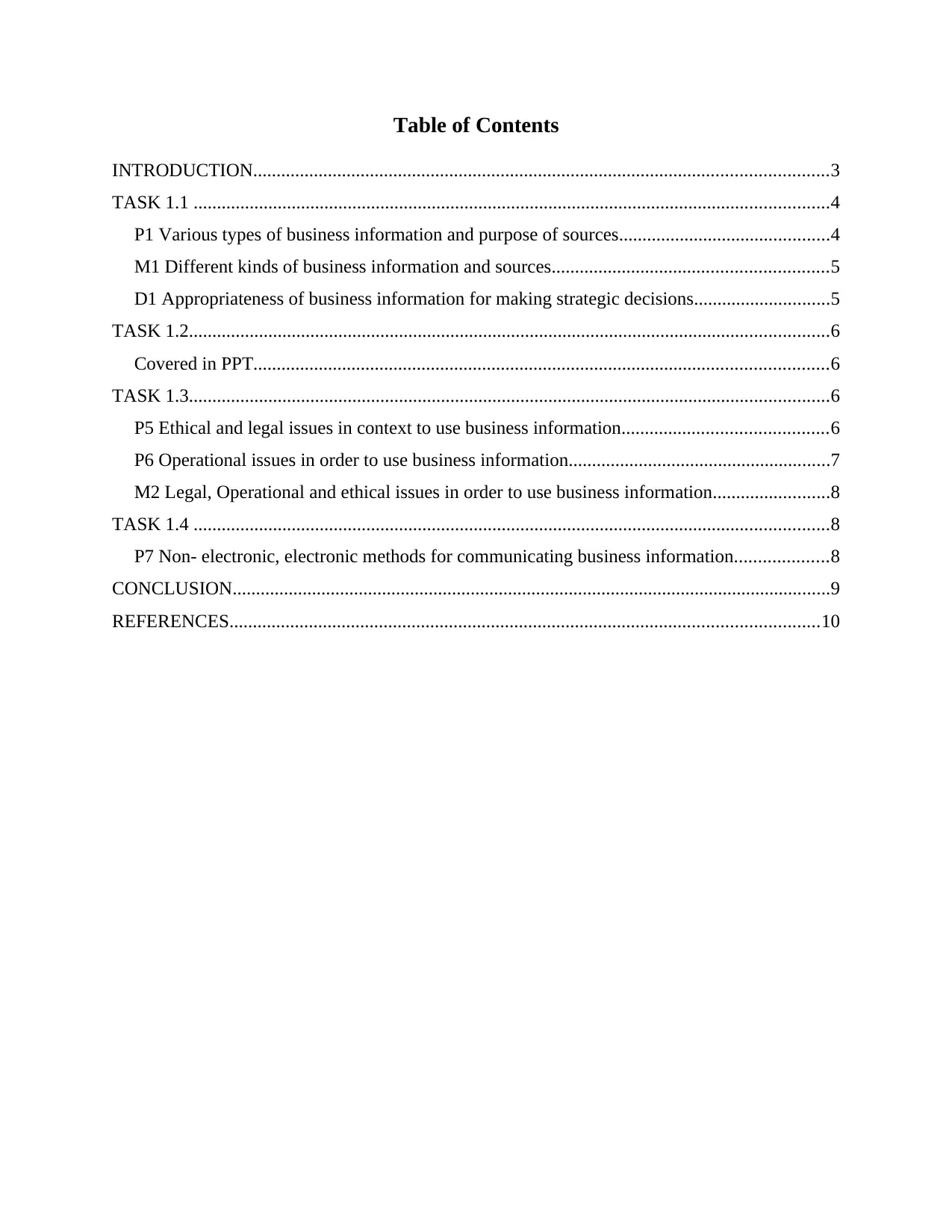
Table of Contents
INTRODUCTION...........................................................................................................................3
TASK 1.1 ........................................................................................................................................4
P1 Various types of business information and purpose of sources.............................................4
M1 Different kinds of business information and sources...........................................................5
D1 Appropriateness of business information for making strategic decisions.............................5
TASK 1.2.........................................................................................................................................6
Covered in PPT...........................................................................................................................6
TASK 1.3.........................................................................................................................................6
P5 Ethical and legal issues in context to use business information............................................6
P6 Operational issues in order to use business information........................................................7
M2 Legal, Operational and ethical issues in order to use business information.........................8
TASK 1.4 ........................................................................................................................................8
P7 Non- electronic, electronic methods for communicating business information....................8
CONCLUSION................................................................................................................................9
REFERENCES..............................................................................................................................10
INTRODUCTION...........................................................................................................................3
TASK 1.1 ........................................................................................................................................4
P1 Various types of business information and purpose of sources.............................................4
M1 Different kinds of business information and sources...........................................................5
D1 Appropriateness of business information for making strategic decisions.............................5
TASK 1.2.........................................................................................................................................6
Covered in PPT...........................................................................................................................6
TASK 1.3.........................................................................................................................................6
P5 Ethical and legal issues in context to use business information............................................6
P6 Operational issues in order to use business information........................................................7
M2 Legal, Operational and ethical issues in order to use business information.........................8
TASK 1.4 ........................................................................................................................................8
P7 Non- electronic, electronic methods for communicating business information....................8
CONCLUSION................................................................................................................................9
REFERENCES..............................................................................................................................10
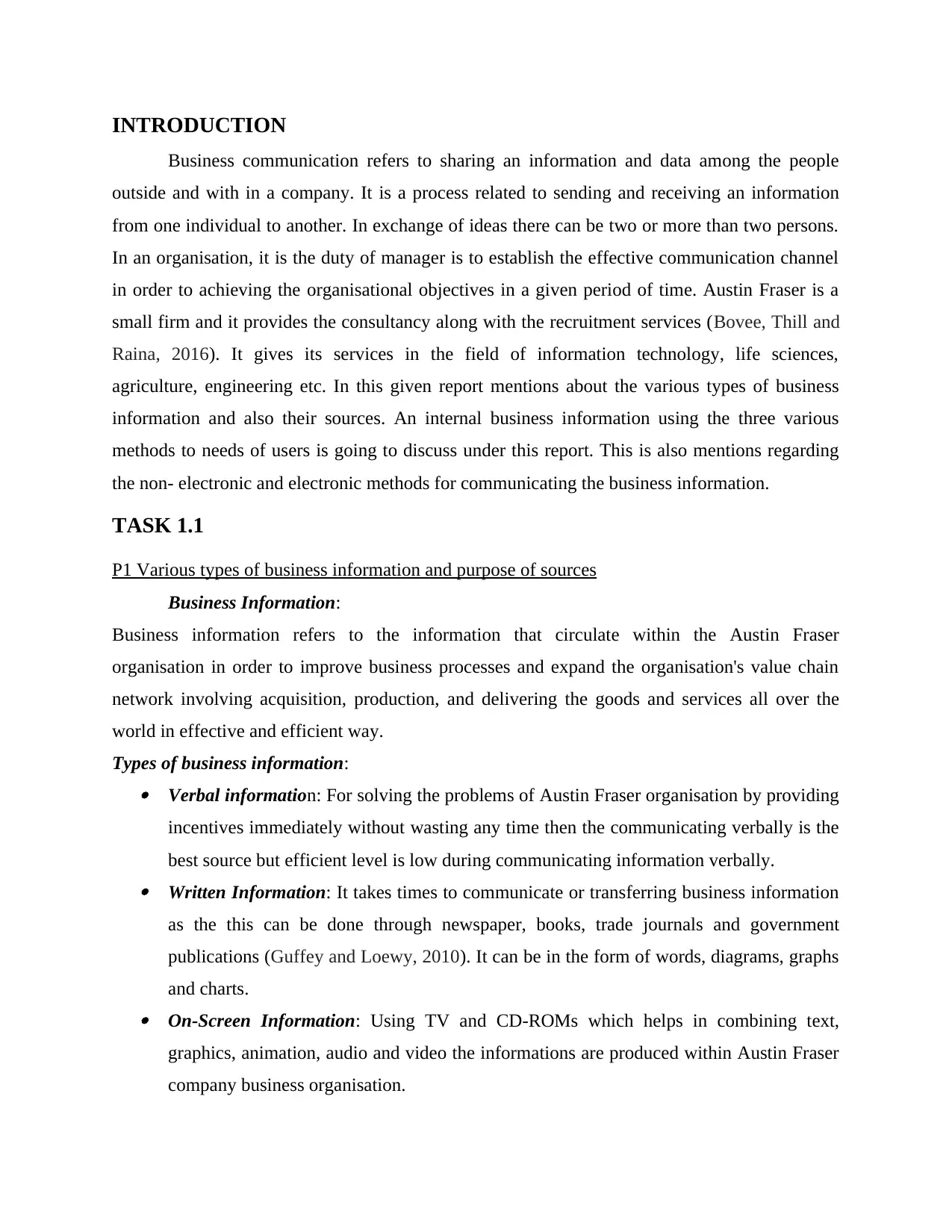
INTRODUCTION
Business communication refers to sharing an information and data among the people
outside and with in a company. It is a process related to sending and receiving an information
from one individual to another. In exchange of ideas there can be two or more than two persons.
In an organisation, it is the duty of manager is to establish the effective communication channel
in order to achieving the organisational objectives in a given period of time. Austin Fraser is a
small firm and it provides the consultancy along with the recruitment services (Bovee, Thill and
Raina, 2016). It gives its services in the field of information technology, life sciences,
agriculture, engineering etc. In this given report mentions about the various types of business
information and also their sources. An internal business information using the three various
methods to needs of users is going to discuss under this report. This is also mentions regarding
the non- electronic and electronic methods for communicating the business information.
TASK 1.1
P1 Various types of business information and purpose of sources
Business Information:
Business information refers to the information that circulate within the Austin Fraser
organisation in order to improve business processes and expand the organisation's value chain
network involving acquisition, production, and delivering the goods and services all over the
world in effective and efficient way.
Types of business information: Verbal information: For solving the problems of Austin Fraser organisation by providing
incentives immediately without wasting any time then the communicating verbally is the
best source but efficient level is low during communicating information verbally. Written Information: It takes times to communicate or transferring business information
as the this can be done through newspaper, books, trade journals and government
publications (Guffey and Loewy, 2010). It can be in the form of words, diagrams, graphs
and charts. On-Screen Information: Using TV and CD-ROMs which helps in combining text,
graphics, animation, audio and video the informations are produced within Austin Fraser
company business organisation.
Business communication refers to sharing an information and data among the people
outside and with in a company. It is a process related to sending and receiving an information
from one individual to another. In exchange of ideas there can be two or more than two persons.
In an organisation, it is the duty of manager is to establish the effective communication channel
in order to achieving the organisational objectives in a given period of time. Austin Fraser is a
small firm and it provides the consultancy along with the recruitment services (Bovee, Thill and
Raina, 2016). It gives its services in the field of information technology, life sciences,
agriculture, engineering etc. In this given report mentions about the various types of business
information and also their sources. An internal business information using the three various
methods to needs of users is going to discuss under this report. This is also mentions regarding
the non- electronic and electronic methods for communicating the business information.
TASK 1.1
P1 Various types of business information and purpose of sources
Business Information:
Business information refers to the information that circulate within the Austin Fraser
organisation in order to improve business processes and expand the organisation's value chain
network involving acquisition, production, and delivering the goods and services all over the
world in effective and efficient way.
Types of business information: Verbal information: For solving the problems of Austin Fraser organisation by providing
incentives immediately without wasting any time then the communicating verbally is the
best source but efficient level is low during communicating information verbally. Written Information: It takes times to communicate or transferring business information
as the this can be done through newspaper, books, trade journals and government
publications (Guffey and Loewy, 2010). It can be in the form of words, diagrams, graphs
and charts. On-Screen Information: Using TV and CD-ROMs which helps in combining text,
graphics, animation, audio and video the informations are produced within Austin Fraser
company business organisation.
⊘ This is a preview!⊘
Do you want full access?
Subscribe today to unlock all pages.

Trusted by 1+ million students worldwide
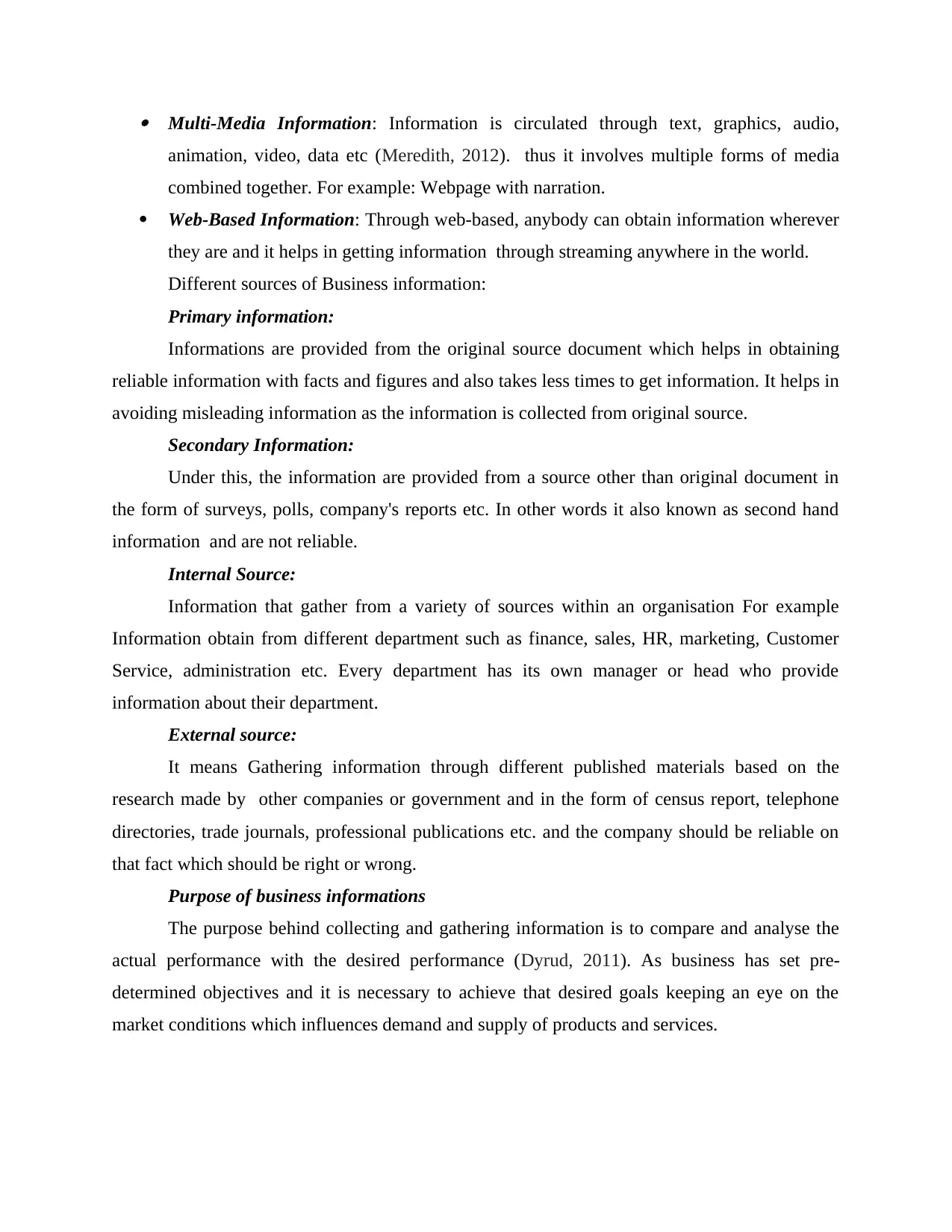
Multi-Media Information: Information is circulated through text, graphics, audio,
animation, video, data etc (Meredith, 2012). thus it involves multiple forms of media
combined together. For example: Webpage with narration.
Web-Based Information: Through web-based, anybody can obtain information wherever
they are and it helps in getting information through streaming anywhere in the world.
Different sources of Business information:
Primary information:
Informations are provided from the original source document which helps in obtaining
reliable information with facts and figures and also takes less times to get information. It helps in
avoiding misleading information as the information is collected from original source.
Secondary Information:
Under this, the information are provided from a source other than original document in
the form of surveys, polls, company's reports etc. In other words it also known as second hand
information and are not reliable.
Internal Source:
Information that gather from a variety of sources within an organisation For example
Information obtain from different department such as finance, sales, HR, marketing, Customer
Service, administration etc. Every department has its own manager or head who provide
information about their department.
External source:
It means Gathering information through different published materials based on the
research made by other companies or government and in the form of census report, telephone
directories, trade journals, professional publications etc. and the company should be reliable on
that fact which should be right or wrong.
Purpose of business informations
The purpose behind collecting and gathering information is to compare and analyse the
actual performance with the desired performance (Dyrud, 2011). As business has set pre-
determined objectives and it is necessary to achieve that desired goals keeping an eye on the
market conditions which influences demand and supply of products and services.
animation, video, data etc (Meredith, 2012). thus it involves multiple forms of media
combined together. For example: Webpage with narration.
Web-Based Information: Through web-based, anybody can obtain information wherever
they are and it helps in getting information through streaming anywhere in the world.
Different sources of Business information:
Primary information:
Informations are provided from the original source document which helps in obtaining
reliable information with facts and figures and also takes less times to get information. It helps in
avoiding misleading information as the information is collected from original source.
Secondary Information:
Under this, the information are provided from a source other than original document in
the form of surveys, polls, company's reports etc. In other words it also known as second hand
information and are not reliable.
Internal Source:
Information that gather from a variety of sources within an organisation For example
Information obtain from different department such as finance, sales, HR, marketing, Customer
Service, administration etc. Every department has its own manager or head who provide
information about their department.
External source:
It means Gathering information through different published materials based on the
research made by other companies or government and in the form of census report, telephone
directories, trade journals, professional publications etc. and the company should be reliable on
that fact which should be right or wrong.
Purpose of business informations
The purpose behind collecting and gathering information is to compare and analyse the
actual performance with the desired performance (Dyrud, 2011). As business has set pre-
determined objectives and it is necessary to achieve that desired goals keeping an eye on the
market conditions which influences demand and supply of products and services.
Paraphrase This Document
Need a fresh take? Get an instant paraphrase of this document with our AI Paraphraser
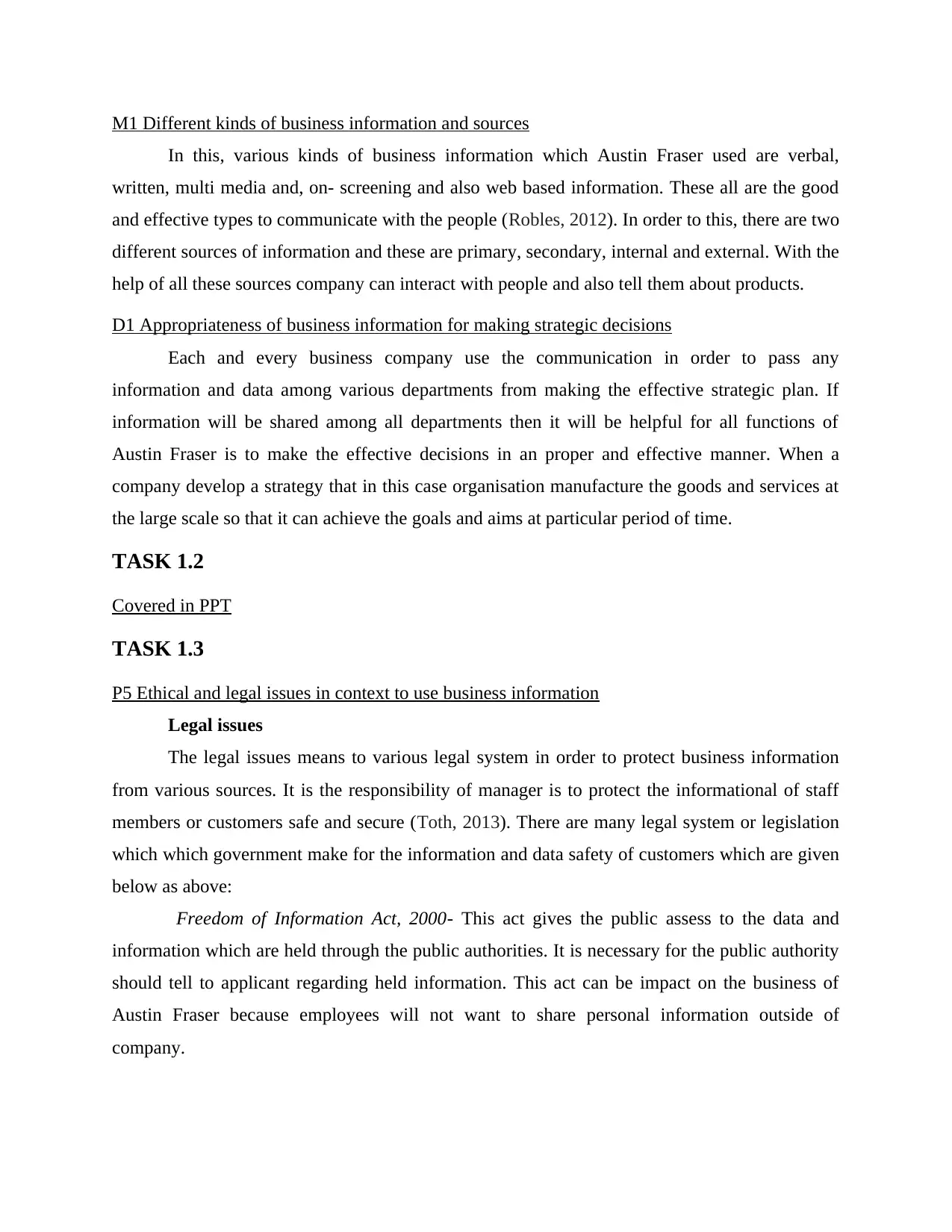
M1 Different kinds of business information and sources
In this, various kinds of business information which Austin Fraser used are verbal,
written, multi media and, on- screening and also web based information. These all are the good
and effective types to communicate with the people (Robles, 2012). In order to this, there are two
different sources of information and these are primary, secondary, internal and external. With the
help of all these sources company can interact with people and also tell them about products.
D1 Appropriateness of business information for making strategic decisions
Each and every business company use the communication in order to pass any
information and data among various departments from making the effective strategic plan. If
information will be shared among all departments then it will be helpful for all functions of
Austin Fraser is to make the effective decisions in an proper and effective manner. When a
company develop a strategy that in this case organisation manufacture the goods and services at
the large scale so that it can achieve the goals and aims at particular period of time.
TASK 1.2
Covered in PPT
TASK 1.3
P5 Ethical and legal issues in context to use business information
Legal issues
The legal issues means to various legal system in order to protect business information
from various sources. It is the responsibility of manager is to protect the informational of staff
members or customers safe and secure (Toth, 2013). There are many legal system or legislation
which which government make for the information and data safety of customers which are given
below as above:
Freedom of Information Act, 2000- This act gives the public assess to the data and
information which are held through the public authorities. It is necessary for the public authority
should tell to applicant regarding held information. This act can be impact on the business of
Austin Fraser because employees will not want to share personal information outside of
company.
In this, various kinds of business information which Austin Fraser used are verbal,
written, multi media and, on- screening and also web based information. These all are the good
and effective types to communicate with the people (Robles, 2012). In order to this, there are two
different sources of information and these are primary, secondary, internal and external. With the
help of all these sources company can interact with people and also tell them about products.
D1 Appropriateness of business information for making strategic decisions
Each and every business company use the communication in order to pass any
information and data among various departments from making the effective strategic plan. If
information will be shared among all departments then it will be helpful for all functions of
Austin Fraser is to make the effective decisions in an proper and effective manner. When a
company develop a strategy that in this case organisation manufacture the goods and services at
the large scale so that it can achieve the goals and aims at particular period of time.
TASK 1.2
Covered in PPT
TASK 1.3
P5 Ethical and legal issues in context to use business information
Legal issues
The legal issues means to various legal system in order to protect business information
from various sources. It is the responsibility of manager is to protect the informational of staff
members or customers safe and secure (Toth, 2013). There are many legal system or legislation
which which government make for the information and data safety of customers which are given
below as above:
Freedom of Information Act, 2000- This act gives the public assess to the data and
information which are held through the public authorities. It is necessary for the public authority
should tell to applicant regarding held information. This act can be impact on the business of
Austin Fraser because employees will not want to share personal information outside of
company.
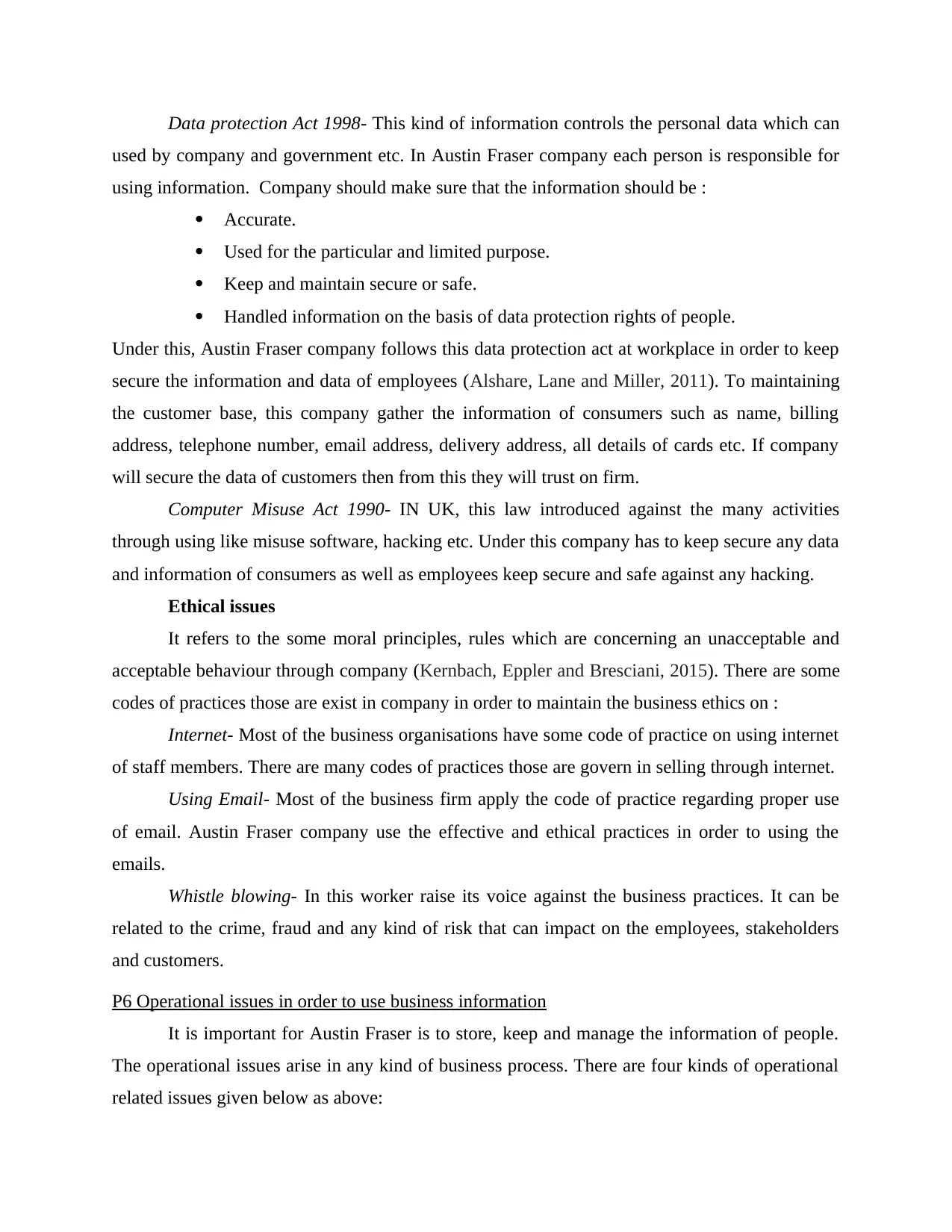
Data protection Act 1998- This kind of information controls the personal data which can
used by company and government etc. In Austin Fraser company each person is responsible for
using information. Company should make sure that the information should be :
Accurate.
Used for the particular and limited purpose.
Keep and maintain secure or safe.
Handled information on the basis of data protection rights of people.
Under this, Austin Fraser company follows this data protection act at workplace in order to keep
secure the information and data of employees (Alshare, Lane and Miller, 2011). To maintaining
the customer base, this company gather the information of consumers such as name, billing
address, telephone number, email address, delivery address, all details of cards etc. If company
will secure the data of customers then from this they will trust on firm.
Computer Misuse Act 1990- IN UK, this law introduced against the many activities
through using like misuse software, hacking etc. Under this company has to keep secure any data
and information of consumers as well as employees keep secure and safe against any hacking.
Ethical issues
It refers to the some moral principles, rules which are concerning an unacceptable and
acceptable behaviour through company (Kernbach, Eppler and Bresciani, 2015). There are some
codes of practices those are exist in company in order to maintain the business ethics on :
Internet- Most of the business organisations have some code of practice on using internet
of staff members. There are many codes of practices those are govern in selling through internet.
Using Email- Most of the business firm apply the code of practice regarding proper use
of email. Austin Fraser company use the effective and ethical practices in order to using the
emails.
Whistle blowing- In this worker raise its voice against the business practices. It can be
related to the crime, fraud and any kind of risk that can impact on the employees, stakeholders
and customers.
P6 Operational issues in order to use business information
It is important for Austin Fraser is to store, keep and manage the information of people.
The operational issues arise in any kind of business process. There are four kinds of operational
related issues given below as above:
used by company and government etc. In Austin Fraser company each person is responsible for
using information. Company should make sure that the information should be :
Accurate.
Used for the particular and limited purpose.
Keep and maintain secure or safe.
Handled information on the basis of data protection rights of people.
Under this, Austin Fraser company follows this data protection act at workplace in order to keep
secure the information and data of employees (Alshare, Lane and Miller, 2011). To maintaining
the customer base, this company gather the information of consumers such as name, billing
address, telephone number, email address, delivery address, all details of cards etc. If company
will secure the data of customers then from this they will trust on firm.
Computer Misuse Act 1990- IN UK, this law introduced against the many activities
through using like misuse software, hacking etc. Under this company has to keep secure any data
and information of consumers as well as employees keep secure and safe against any hacking.
Ethical issues
It refers to the some moral principles, rules which are concerning an unacceptable and
acceptable behaviour through company (Kernbach, Eppler and Bresciani, 2015). There are some
codes of practices those are exist in company in order to maintain the business ethics on :
Internet- Most of the business organisations have some code of practice on using internet
of staff members. There are many codes of practices those are govern in selling through internet.
Using Email- Most of the business firm apply the code of practice regarding proper use
of email. Austin Fraser company use the effective and ethical practices in order to using the
emails.
Whistle blowing- In this worker raise its voice against the business practices. It can be
related to the crime, fraud and any kind of risk that can impact on the employees, stakeholders
and customers.
P6 Operational issues in order to use business information
It is important for Austin Fraser is to store, keep and manage the information of people.
The operational issues arise in any kind of business process. There are four kinds of operational
related issues given below as above:
⊘ This is a preview!⊘
Do you want full access?
Subscribe today to unlock all pages.

Trusted by 1+ million students worldwide
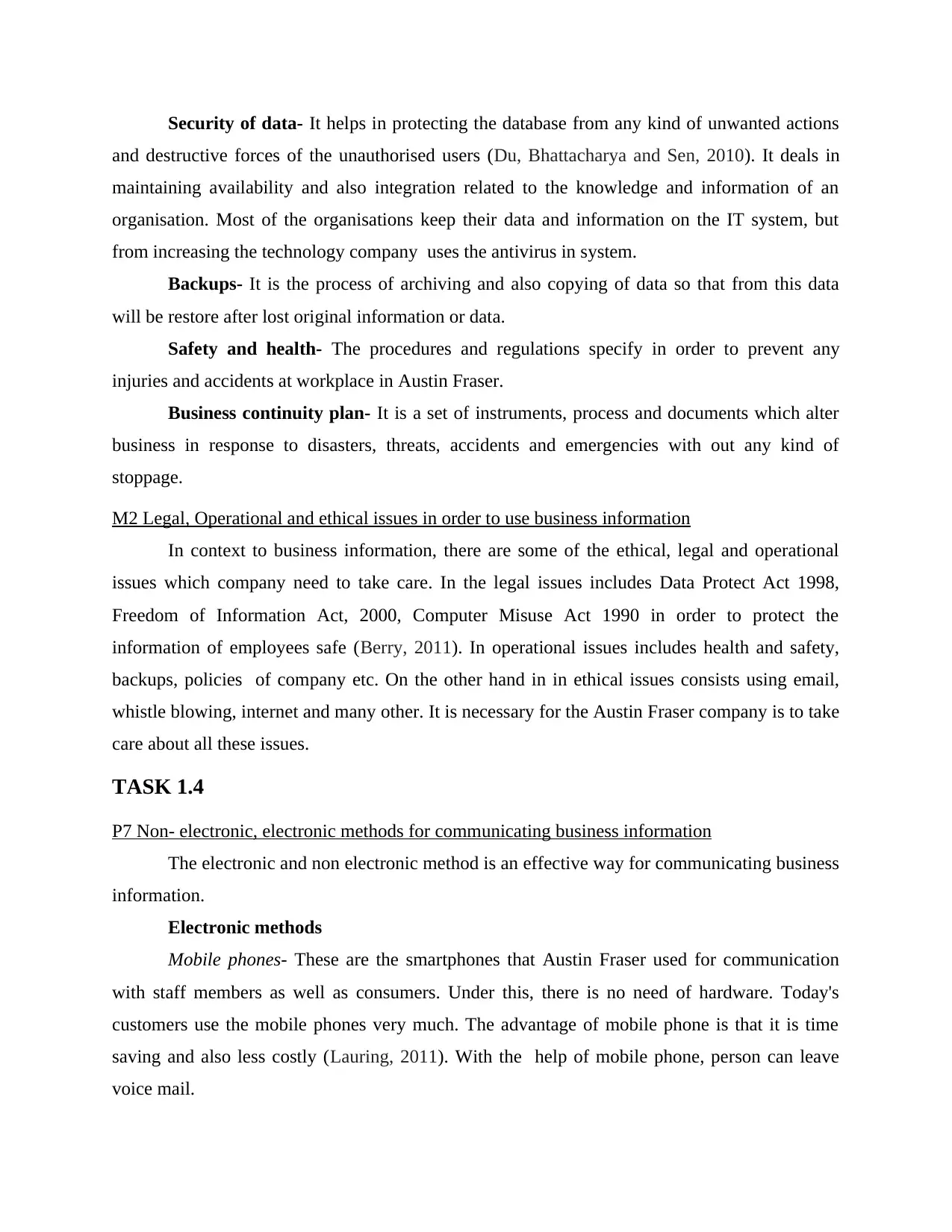
Security of data- It helps in protecting the database from any kind of unwanted actions
and destructive forces of the unauthorised users (Du, Bhattacharya and Sen, 2010). It deals in
maintaining availability and also integration related to the knowledge and information of an
organisation. Most of the organisations keep their data and information on the IT system, but
from increasing the technology company uses the antivirus in system.
Backups- It is the process of archiving and also copying of data so that from this data
will be restore after lost original information or data.
Safety and health- The procedures and regulations specify in order to prevent any
injuries and accidents at workplace in Austin Fraser.
Business continuity plan- It is a set of instruments, process and documents which alter
business in response to disasters, threats, accidents and emergencies with out any kind of
stoppage.
M2 Legal, Operational and ethical issues in order to use business information
In context to business information, there are some of the ethical, legal and operational
issues which company need to take care. In the legal issues includes Data Protect Act 1998,
Freedom of Information Act, 2000, Computer Misuse Act 1990 in order to protect the
information of employees safe (Berry, 2011). In operational issues includes health and safety,
backups, policies of company etc. On the other hand in in ethical issues consists using email,
whistle blowing, internet and many other. It is necessary for the Austin Fraser company is to take
care about all these issues.
TASK 1.4
P7 Non- electronic, electronic methods for communicating business information
The electronic and non electronic method is an effective way for communicating business
information.
Electronic methods
Mobile phones- These are the smartphones that Austin Fraser used for communication
with staff members as well as consumers. Under this, there is no need of hardware. Today's
customers use the mobile phones very much. The advantage of mobile phone is that it is time
saving and also less costly (Lauring, 2011). With the help of mobile phone, person can leave
voice mail.
and destructive forces of the unauthorised users (Du, Bhattacharya and Sen, 2010). It deals in
maintaining availability and also integration related to the knowledge and information of an
organisation. Most of the organisations keep their data and information on the IT system, but
from increasing the technology company uses the antivirus in system.
Backups- It is the process of archiving and also copying of data so that from this data
will be restore after lost original information or data.
Safety and health- The procedures and regulations specify in order to prevent any
injuries and accidents at workplace in Austin Fraser.
Business continuity plan- It is a set of instruments, process and documents which alter
business in response to disasters, threats, accidents and emergencies with out any kind of
stoppage.
M2 Legal, Operational and ethical issues in order to use business information
In context to business information, there are some of the ethical, legal and operational
issues which company need to take care. In the legal issues includes Data Protect Act 1998,
Freedom of Information Act, 2000, Computer Misuse Act 1990 in order to protect the
information of employees safe (Berry, 2011). In operational issues includes health and safety,
backups, policies of company etc. On the other hand in in ethical issues consists using email,
whistle blowing, internet and many other. It is necessary for the Austin Fraser company is to take
care about all these issues.
TASK 1.4
P7 Non- electronic, electronic methods for communicating business information
The electronic and non electronic method is an effective way for communicating business
information.
Electronic methods
Mobile phones- These are the smartphones that Austin Fraser used for communication
with staff members as well as consumers. Under this, there is no need of hardware. Today's
customers use the mobile phones very much. The advantage of mobile phone is that it is time
saving and also less costly (Lauring, 2011). With the help of mobile phone, person can leave
voice mail.
Paraphrase This Document
Need a fresh take? Get an instant paraphrase of this document with our AI Paraphraser
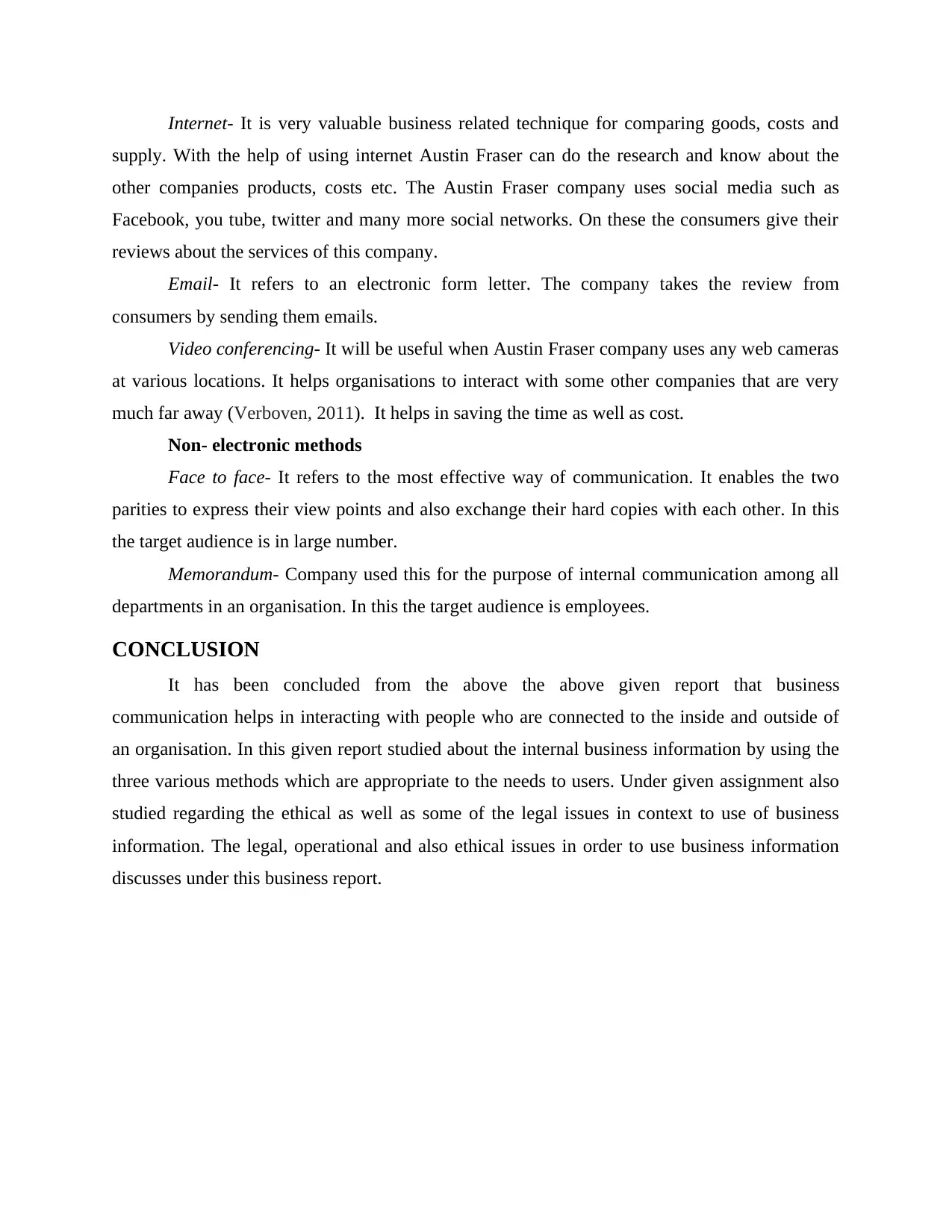
Internet- It is very valuable business related technique for comparing goods, costs and
supply. With the help of using internet Austin Fraser can do the research and know about the
other companies products, costs etc. The Austin Fraser company uses social media such as
Facebook, you tube, twitter and many more social networks. On these the consumers give their
reviews about the services of this company.
Email- It refers to an electronic form letter. The company takes the review from
consumers by sending them emails.
Video conferencing- It will be useful when Austin Fraser company uses any web cameras
at various locations. It helps organisations to interact with some other companies that are very
much far away (Verboven, 2011). It helps in saving the time as well as cost.
Non- electronic methods
Face to face- It refers to the most effective way of communication. It enables the two
parities to express their view points and also exchange their hard copies with each other. In this
the target audience is in large number.
Memorandum- Company used this for the purpose of internal communication among all
departments in an organisation. In this the target audience is employees.
CONCLUSION
It has been concluded from the above the above given report that business
communication helps in interacting with people who are connected to the inside and outside of
an organisation. In this given report studied about the internal business information by using the
three various methods which are appropriate to the needs to users. Under given assignment also
studied regarding the ethical as well as some of the legal issues in context to use of business
information. The legal, operational and also ethical issues in order to use business information
discusses under this business report.
supply. With the help of using internet Austin Fraser can do the research and know about the
other companies products, costs etc. The Austin Fraser company uses social media such as
Facebook, you tube, twitter and many more social networks. On these the consumers give their
reviews about the services of this company.
Email- It refers to an electronic form letter. The company takes the review from
consumers by sending them emails.
Video conferencing- It will be useful when Austin Fraser company uses any web cameras
at various locations. It helps organisations to interact with some other companies that are very
much far away (Verboven, 2011). It helps in saving the time as well as cost.
Non- electronic methods
Face to face- It refers to the most effective way of communication. It enables the two
parities to express their view points and also exchange their hard copies with each other. In this
the target audience is in large number.
Memorandum- Company used this for the purpose of internal communication among all
departments in an organisation. In this the target audience is employees.
CONCLUSION
It has been concluded from the above the above given report that business
communication helps in interacting with people who are connected to the inside and outside of
an organisation. In this given report studied about the internal business information by using the
three various methods which are appropriate to the needs to users. Under given assignment also
studied regarding the ethical as well as some of the legal issues in context to use of business
information. The legal, operational and also ethical issues in order to use business information
discusses under this business report.
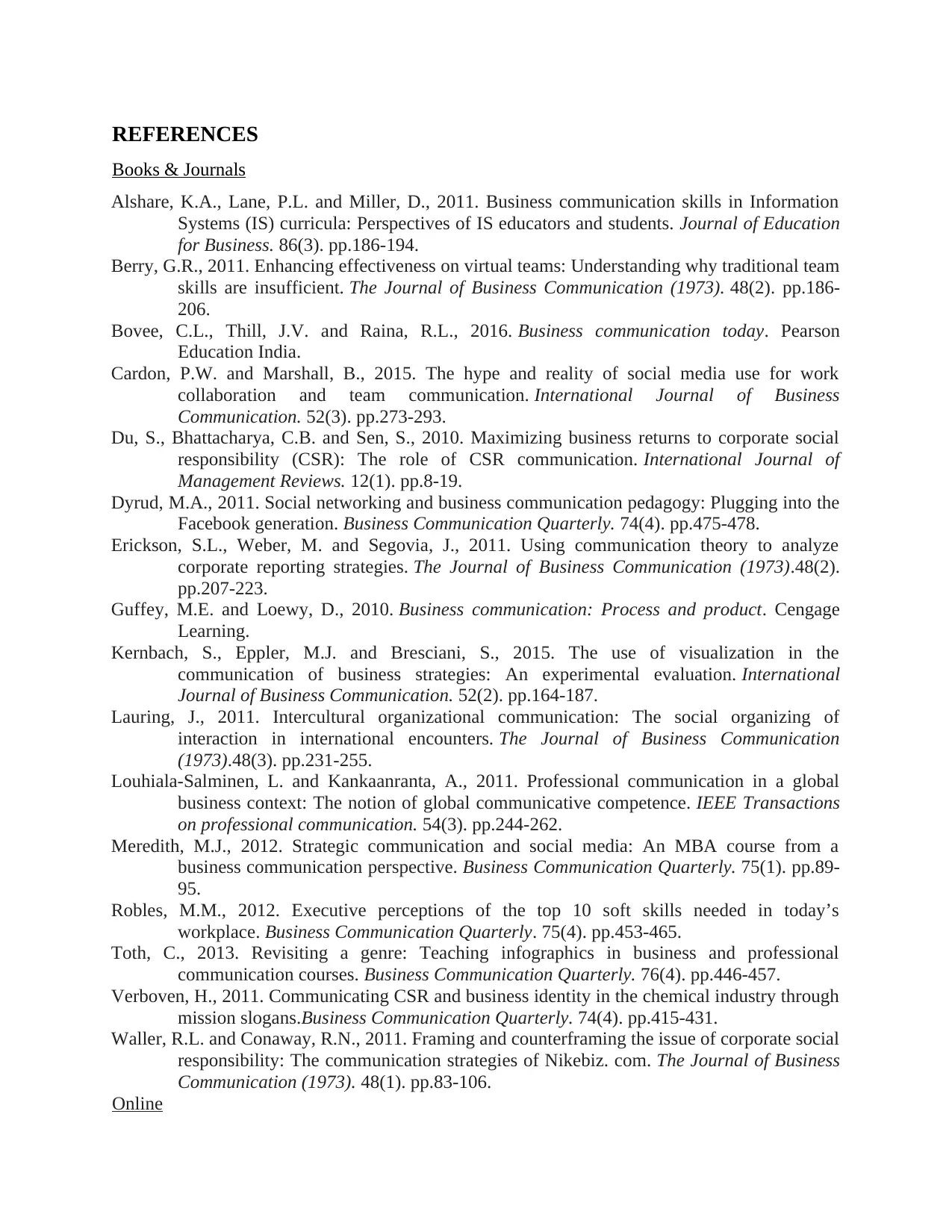
REFERENCES
Books & Journals
Alshare, K.A., Lane, P.L. and Miller, D., 2011. Business communication skills in Information
Systems (IS) curricula: Perspectives of IS educators and students. Journal of Education
for Business. 86(3). pp.186-194.
Berry, G.R., 2011. Enhancing effectiveness on virtual teams: Understanding why traditional team
skills are insufficient. The Journal of Business Communication (1973). 48(2). pp.186-
206.
Bovee, C.L., Thill, J.V. and Raina, R.L., 2016. Business communication today. Pearson
Education India.
Cardon, P.W. and Marshall, B., 2015. The hype and reality of social media use for work
collaboration and team communication. International Journal of Business
Communication. 52(3). pp.273-293.
Du, S., Bhattacharya, C.B. and Sen, S., 2010. Maximizing business returns to corporate social
responsibility (CSR): The role of CSR communication. International Journal of
Management Reviews. 12(1). pp.8-19.
Dyrud, M.A., 2011. Social networking and business communication pedagogy: Plugging into the
Facebook generation. Business Communication Quarterly. 74(4). pp.475-478.
Erickson, S.L., Weber, M. and Segovia, J., 2011. Using communication theory to analyze
corporate reporting strategies. The Journal of Business Communication (1973).48(2).
pp.207-223.
Guffey, M.E. and Loewy, D., 2010. Business communication: Process and product. Cengage
Learning.
Kernbach, S., Eppler, M.J. and Bresciani, S., 2015. The use of visualization in the
communication of business strategies: An experimental evaluation. International
Journal of Business Communication. 52(2). pp.164-187.
Lauring, J., 2011. Intercultural organizational communication: The social organizing of
interaction in international encounters. The Journal of Business Communication
(1973).48(3). pp.231-255.
Louhiala-Salminen, L. and Kankaanranta, A., 2011. Professional communication in a global
business context: The notion of global communicative competence. IEEE Transactions
on professional communication. 54(3). pp.244-262.
Meredith, M.J., 2012. Strategic communication and social media: An MBA course from a
business communication perspective. Business Communication Quarterly. 75(1). pp.89-
95.
Robles, M.M., 2012. Executive perceptions of the top 10 soft skills needed in today’s
workplace. Business Communication Quarterly. 75(4). pp.453-465.
Toth, C., 2013. Revisiting a genre: Teaching infographics in business and professional
communication courses. Business Communication Quarterly. 76(4). pp.446-457.
Verboven, H., 2011. Communicating CSR and business identity in the chemical industry through
mission slogans.Business Communication Quarterly. 74(4). pp.415-431.
Waller, R.L. and Conaway, R.N., 2011. Framing and counterframing the issue of corporate social
responsibility: The communication strategies of Nikebiz. com. The Journal of Business
Communication (1973). 48(1). pp.83-106.
Online
Books & Journals
Alshare, K.A., Lane, P.L. and Miller, D., 2011. Business communication skills in Information
Systems (IS) curricula: Perspectives of IS educators and students. Journal of Education
for Business. 86(3). pp.186-194.
Berry, G.R., 2011. Enhancing effectiveness on virtual teams: Understanding why traditional team
skills are insufficient. The Journal of Business Communication (1973). 48(2). pp.186-
206.
Bovee, C.L., Thill, J.V. and Raina, R.L., 2016. Business communication today. Pearson
Education India.
Cardon, P.W. and Marshall, B., 2015. The hype and reality of social media use for work
collaboration and team communication. International Journal of Business
Communication. 52(3). pp.273-293.
Du, S., Bhattacharya, C.B. and Sen, S., 2010. Maximizing business returns to corporate social
responsibility (CSR): The role of CSR communication. International Journal of
Management Reviews. 12(1). pp.8-19.
Dyrud, M.A., 2011. Social networking and business communication pedagogy: Plugging into the
Facebook generation. Business Communication Quarterly. 74(4). pp.475-478.
Erickson, S.L., Weber, M. and Segovia, J., 2011. Using communication theory to analyze
corporate reporting strategies. The Journal of Business Communication (1973).48(2).
pp.207-223.
Guffey, M.E. and Loewy, D., 2010. Business communication: Process and product. Cengage
Learning.
Kernbach, S., Eppler, M.J. and Bresciani, S., 2015. The use of visualization in the
communication of business strategies: An experimental evaluation. International
Journal of Business Communication. 52(2). pp.164-187.
Lauring, J., 2011. Intercultural organizational communication: The social organizing of
interaction in international encounters. The Journal of Business Communication
(1973).48(3). pp.231-255.
Louhiala-Salminen, L. and Kankaanranta, A., 2011. Professional communication in a global
business context: The notion of global communicative competence. IEEE Transactions
on professional communication. 54(3). pp.244-262.
Meredith, M.J., 2012. Strategic communication and social media: An MBA course from a
business communication perspective. Business Communication Quarterly. 75(1). pp.89-
95.
Robles, M.M., 2012. Executive perceptions of the top 10 soft skills needed in today’s
workplace. Business Communication Quarterly. 75(4). pp.453-465.
Toth, C., 2013. Revisiting a genre: Teaching infographics in business and professional
communication courses. Business Communication Quarterly. 76(4). pp.446-457.
Verboven, H., 2011. Communicating CSR and business identity in the chemical industry through
mission slogans.Business Communication Quarterly. 74(4). pp.415-431.
Waller, R.L. and Conaway, R.N., 2011. Framing and counterframing the issue of corporate social
responsibility: The communication strategies of Nikebiz. com. The Journal of Business
Communication (1973). 48(1). pp.83-106.
Online
⊘ This is a preview!⊘
Do you want full access?
Subscribe today to unlock all pages.

Trusted by 1+ million students worldwide
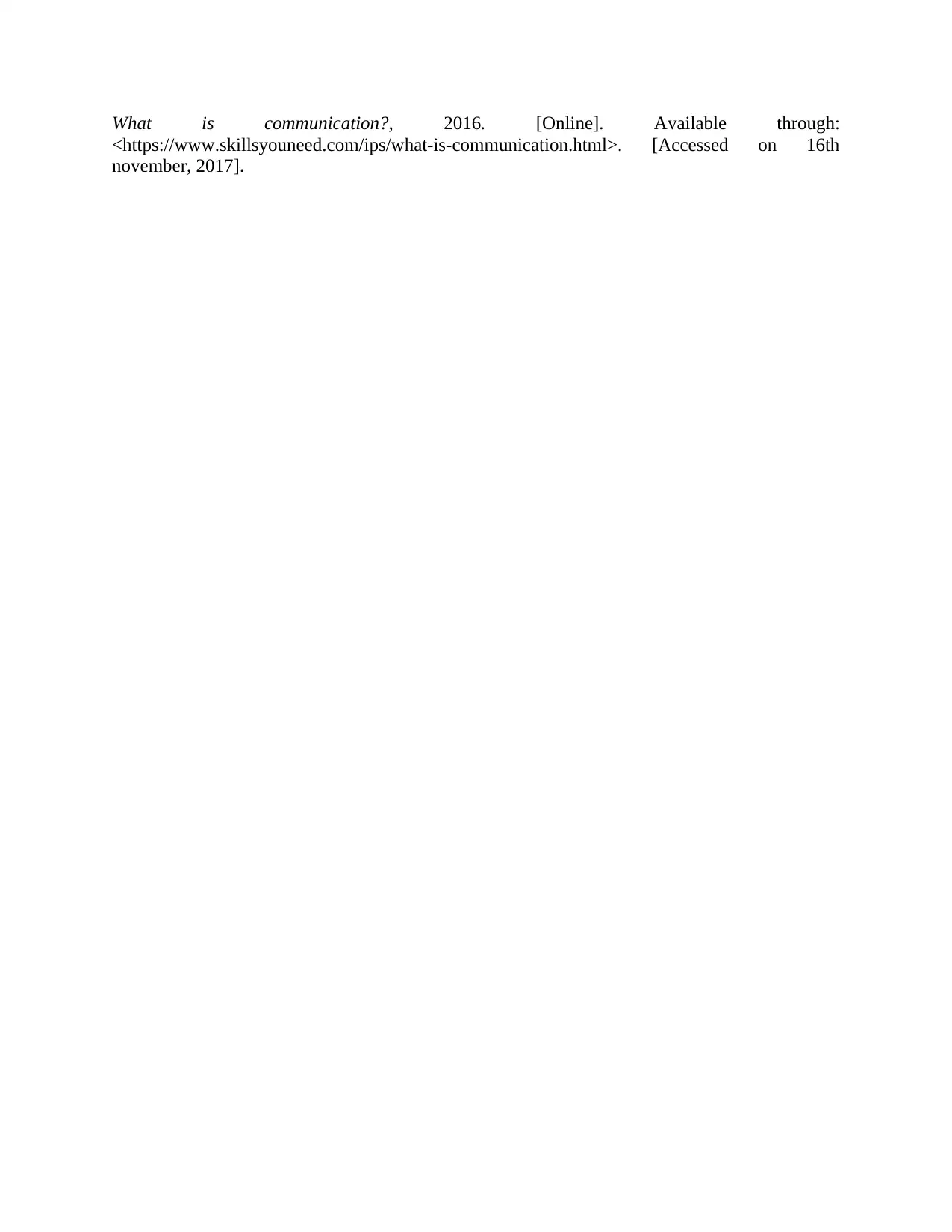
What is communication?, 2016. [Online]. Available through:
<https://www.skillsyouneed.com/ips/what-is-communication.html>. [Accessed on 16th
november, 2017].
<https://www.skillsyouneed.com/ips/what-is-communication.html>. [Accessed on 16th
november, 2017].
1 out of 10
Related Documents
Your All-in-One AI-Powered Toolkit for Academic Success.
+13062052269
info@desklib.com
Available 24*7 on WhatsApp / Email
![[object Object]](/_next/static/media/star-bottom.7253800d.svg)
Unlock your academic potential
Copyright © 2020–2025 A2Z Services. All Rights Reserved. Developed and managed by ZUCOL.





